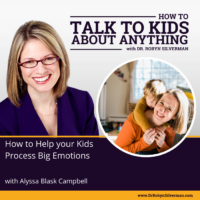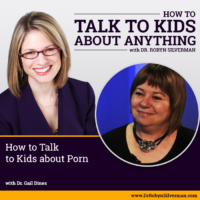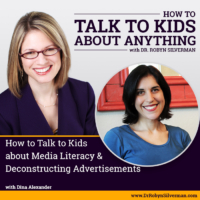Podcast: Play in new window | Download
Subscribe: Apple Podcasts | RSS | More
How to Talk to Kids about Emotions, Boundaries, Transitions & Conflict

This podcast will focus on how to help little kids navigate big emotions in specific common situations. Alyssa Blask Campbell of Seed and Sew will help us understand what to do and say to help our kids (and ourselves) through those frustrating situations so we don’t get derailed and get to the other side!
Special guest: Alyssa Blask Campbell
Most little kids have big emotions. But they don’t come with a guide book that tell us how to cope with those emotions, how to set boundaries before, during and after big emotions, how to deal with transitions that bring up big emotions and how to cope with conflict that triggers big emotions. Understanding kids and feelings while understanding the role we play in helping our kids manage those emotions can make a big difference. We’ve talked to Dr. Lynne Kenney, Karen Young, Mona Delahooke, Dr. Laura Markham and Wendy Young about children and feelings in the past—and today we are going to dive into how to help kids cope with big emotions in specific situations that are common but often derailing for parents and kids. How do we manage emotions when our children aren’t getting what they want in that moment? How do we manage emotions when there’s a transition or new situation about to take place? How do we deal with emotions when sibling rivalry is rampant? For all of this, we are turning to Alyssa Blask Campbell.
Bio
Alyssa is the founder & CEO of Seed & Sew, an organization committed to giving parents, teachers, and caregivers the tools to raise emotionally intelligent humans. Seed & Sew offers a one-of-a-kind certification program for childcare centers and home-based providers through the Schools Excelling in Emotional Development (S.E.E.D.) Certification. An emotional development expert with a master’s degree in early education, Alyssa co-created the Collaborative Emotion Processing (CEP) method, which is unique in how it equips adults to be mindful of their own emotional intelligence so they can show up for the kids in their lives in a productive way. As an early childhood educator and parent, Seed & Sew provides the tools that Alyssa needed but never had: an in-person and online community where parents and educators can find the support they need to do the work for themselves and with tiny humans. You can find more information at SeedandSew.org
Important Messages:
-
- I’m not responsible for that first thought or that first reaction, but I am responsible for the second one or for that action.
- Resilience and kids: First; let them know that it makes sense to feel what they’re feeling. “yeah, I get that. That makes sense.” You don’t have to agree with why they’re feeling, what they’re feeling like if a kid’s block tower crashes (a sibling comes in and knocks it down for you). Might feel like not a big deal. Right? You can build it again! But if I take a step back and I think about the other day when I folded all the laundry in my living room and had piles out and my toddler came in and knocked down all my piles. I don’t want to fold it again. That misses the point.
- Say; “I get that. Sometimes I get really into something that I’m doing at work and I don’t want to stop. I’m having a lot of fun with what I’m doing or the other night I went out to dinner with your dad and we were having a really good time. And then we knew that we had to get back cause the babysitter had to leave and it was hard to leave.” Feel seen and heard.
- What are the boundaries in your home? Example; boundaries around expression. “You are allowed to feel frustrated and sad. I won’t let you hurt my body. Our boundaries in our household are (1) respect of all bodies and things. (2) No name callings, including yourself. “I’m so stupid.” vs “You made a stupid choice.” (3) You’re allowed to cry. No matter what age.
- BRAIN: You don’t have access to your whole brain when you’re in the heat of the moment. You’re in that fight flight freeze fawn mode. Amygdala: activated.
- CO-REGULATE: Calming. (Example) Move body (ran down and touched the fence) I’m helping their body get to a place where they can even talk about it, where they can access that.
- SENSORY BANK: When we say the word sensory, we’re talking about your nervous system as a whole. When kids wake up in the morning, we’re not like, we don’t wait until they’re hangry and then we’ll feed them- that would be bonkers– we stay ahead of it. We give them breakfast, we give them snack, we give them lunch. We give them snack. We give them dinner. There’s so much food. We pour proactively into their nervous system, so they don’t get to the place of being hangry. We have eight sensory systems. And so we want to pour into the nervous system as a whole, throughout the day. We do that with sleep, nap, with food, movement and then downtime.
- Movement every 90 minutes or 2 hours. Example- jumping into a pile of pillows or having a relay race or doing jumping jacks. Want kids to realize: this is what my body needs right now to help replenish there. And we, we’re going to turn to these things both in the moment, but also proactively do that ahead of time because that your nervous system is doing so much work all day long to keep you safe.
- How do your kids reset? Books, coloring, physical play, something else?
- Five phases of emotion processing are what we go through to process an emotion. The first four are about connecting and helping them calm their nervous system. And then the very last one is about talking about it, problem solving conflict resolution, etc. And the first one is allowing them to feel with boundaries (different depending on situation).
- Here’s what to expect. Here are the rules. If you’re feeling frustrated, if you’re feeling upset, (tools up front, when they’re in a regulated state, when they have access to that whole brain to let them know what they can say, what they can do before we’re in it, can be helpful).
- Emotion coach: Don’t have to agree with the feeling to help them through it. “You won’t feel this way forever.” “It’s really frustrating when you want to watch my phone because we’re waiting for food” In a very stimulating environment, the phone can distract their nervous system and give them some dopamine that will numb. If they are feeling dysregulated. If they’re hangry, if they’re overstimulated, it’s going to be a dopamine hit. What are some other ways they can get dopamine? There are lots of withdrawals. So play a game- or other ways to get dopamine hit.
- Pre-teaching.
- RESEARCH: Neuro divergent humans specifically in ADHD right now, baseline dopamine levels in your body– noticing that for ADHD, that having access to dopamine first can act as a bridge to being able to access that coping strategy or what we look at as serotonin or oxytocin. Calm nervous system first. Moving body, game, distraction- so that they can access the strategy. Options like telling a story, looking outside, being playful, stuffed animal talking.
- Address the issue: “I love you. And I’m not mad at you. You’re not in trouble. I noticed earlier you were having a hard time that your body felt out of control and your sister came in the room and I’m wondering if you thought that she was going to come wreck that train track you’d been working so hard on.”
- Don’t forget to take care of you—eating and sleeping.
- Child hurt? Turn to the child, who’s crying and connect with them really quickly, but really the one who needs your help in that moment is the one who threw the train– which is a hard shift for us as adults. A lot of the times, a lot of us did not grow up with “the person who got hit by the train gets the connection.” and it can feel like we’re rewarding it or it’s attention seeking. And now we’re giving it attention. We’re feeding it. We might, as the adult have a lot of things that come up for us and that’s our bag to carry. That’s not that we’ll do that work outside of the moment.
- “well, man, you were coming into play and that hurt your body. I love you. And I’m going to be right here. I’m going to help your brother so we can figure this out together. And then it’s your turn.” So she knows I’m here. I hear you. (If she’s bleeding and needs like real attention, pay attention to her first!)
- ONLOOKER LEARNS TOO: , the sister is seeing that she gets to make mistakes sometimes too, and that we can work through this together and that I love you no matter what, I don’t just love you. And I’m not just here to help you when you are obedient, when you’re regulated, when you’re calm, when you’re happy, I love you. And I’m here to help you when you’re having a hard time too.
- When everybody’s calm, then I’m – bring everyone together for conflict resolution. Must be regulated first.
- Big festival: Lots of people- preteach? One, I would let them know what to expect as best you can. “I’m so curious what there what’s going to be there and who we might see. I don’t know if we’ll see people we know, or if we’re going to meet new people.” On the way there- I knew they were going to be giving out capes for kids that were. “And when we get there, there’s going to be a lot of people. And some of them are my friends and they know who I am. And some of them, I don’t know yet when we get there, first, I walked through like, what’s going to happen. We’re going to get there. We’re going to go inside and have lunch. And then we’re going to go outside and people are going to talk. And here’s what you can do when they’re talking. If you’re feeling bored or you don’t want to listen to them…” and gave him an outline of the day.
- Prepare for questions! “ when we go in and my friends are excited to see me, they might say, hi, Alyssa. And they’ve never met you before. And when somebody’s meeting you for the first time, what do you think they might ask you?”
- Give them ideas of what will happen and what they can say.
- Nonverbal: “Squeeze my had if you are feeling…”
- Sensory bank- in advance. Pour into your child’s sensory bank. Some situations pull from a child’s nervous system. So get in some movement, make sure they have food and make sure they are rested. Then you are setting them up for success. NOT FAILING FOR FEELING. Feeling is okay and normal. The goal isn’t for anyone in this world to be regulated and happy all the time… And when a child is having a hard time with an emotion, when he isn’t happy, when he isn’t calm, a parent is not failing because he’s having a hard time. He’s human and he’s going to have different emotions too. No one on this planet earth, unless there’s a chemical imbalance, is in a regulated state all the time. And it’s not the goal.
Notable Quotables:
- “Adults, if phones aren’t an option for kids, they’re not an option for you.”
- “Kids come up with good ideas to solve problems. We don’t have to brainstorm ideas with them. We just have to scaffold that conversation.”
- “Pour into your child’s sensory bank. Some situations pull from a child’s nervous system. So get in some movement, make sure they have food and make sure they are rested. Then you are setting them up for success.”
- “The goal isn’t for anyone in this world to be regulated and happy all the time… And when a child is having a hard time with an emotion, when he isn’t happy, when he isn’t calm, a parent is not failing because he’s having a hard time. He’s human and he’s going to have different emotions too. No one on this planet earth, unless there’s a chemical imbalance, is in a regulated state all the time. And it’s not the goal.”
- “A parent is not failing for feeling.”
A parent is not failing for feeling, says Alyssa Blask Campbell of Seed & Sew. We are human and all of us show emotions! Listen in on #talktokids podcast
Click To Tweet
Resources:
Social Media for Dr. Robyn:
- facebook.com/DrRobynSilverman
- twitter.com/DrRobyn
- instagram.com/DrRobynSilverman
- facebook.com/HowToTalkToKidsaboutAnything
The post How to Talk to Kids about Emotions, Boundaries, Transitions & Conflict with Alyssa Blask Campbell appeared first on drrobynsilverman.com.








